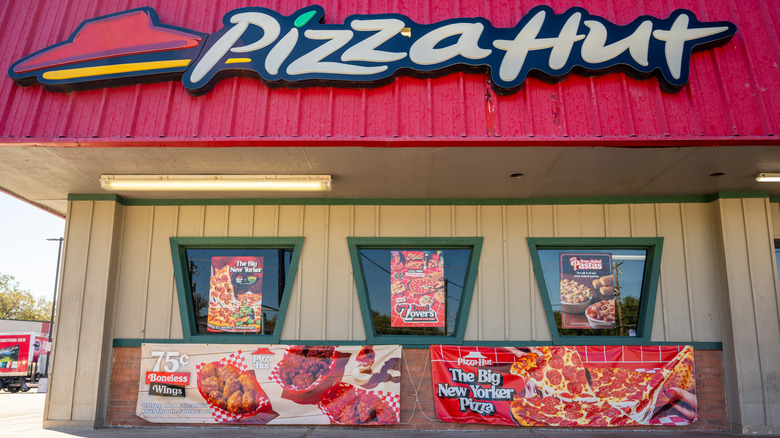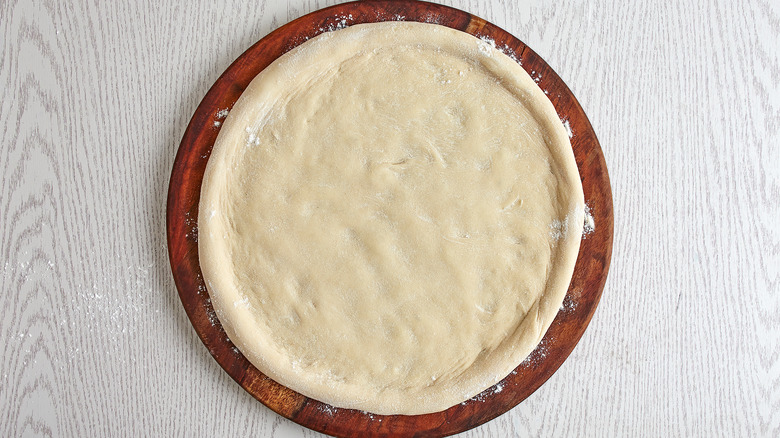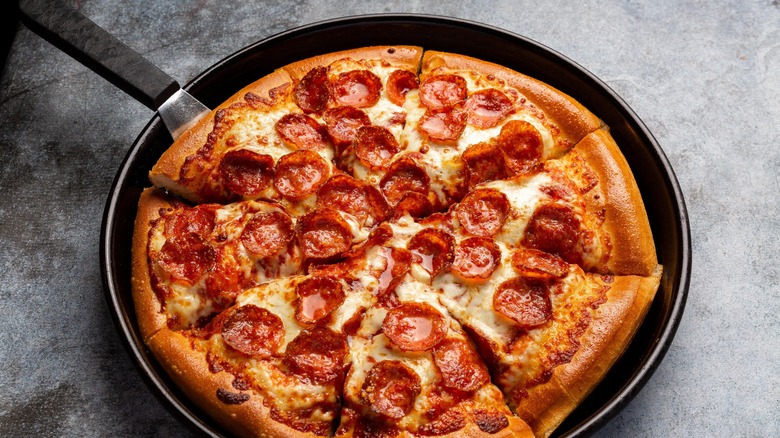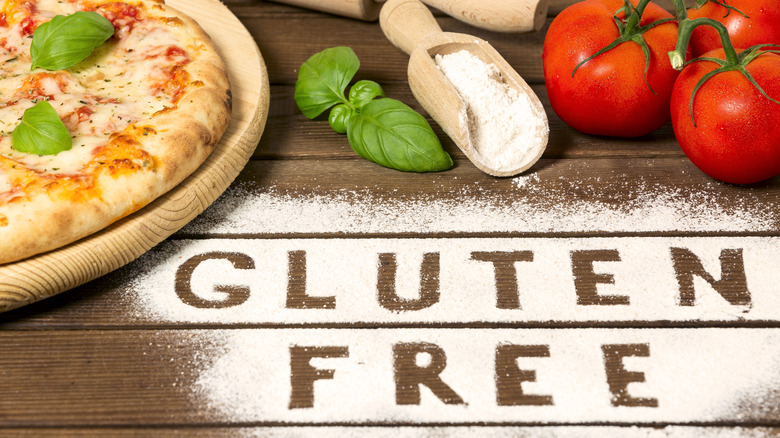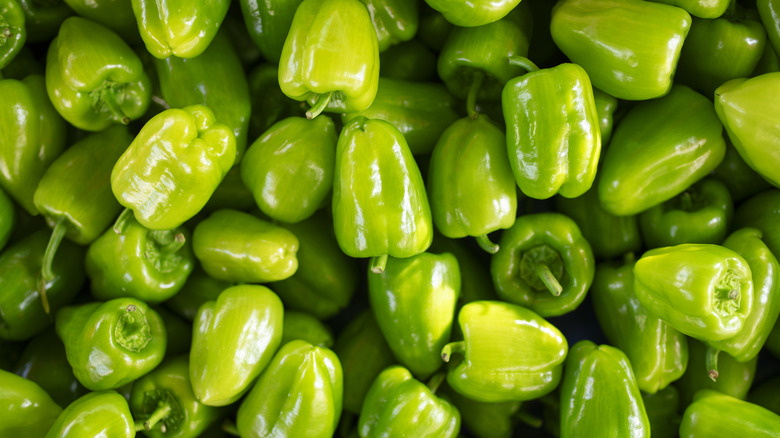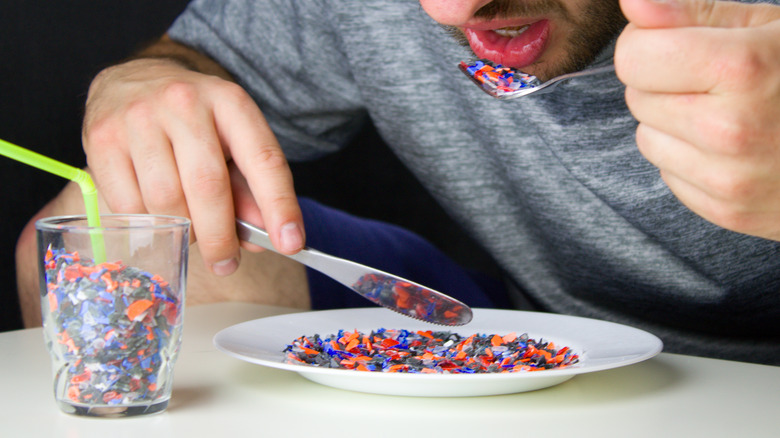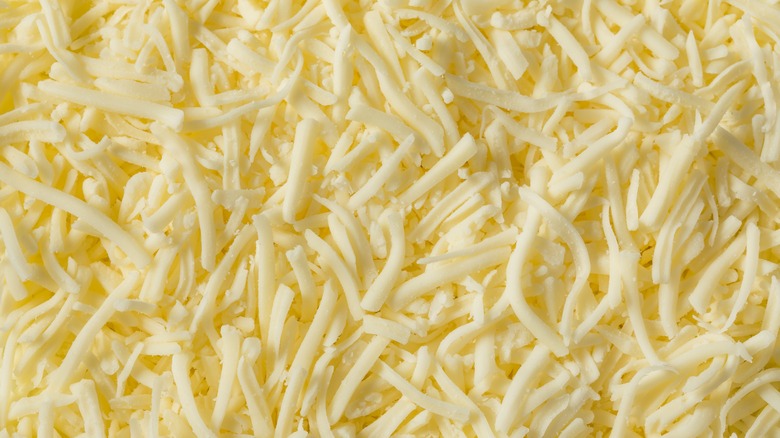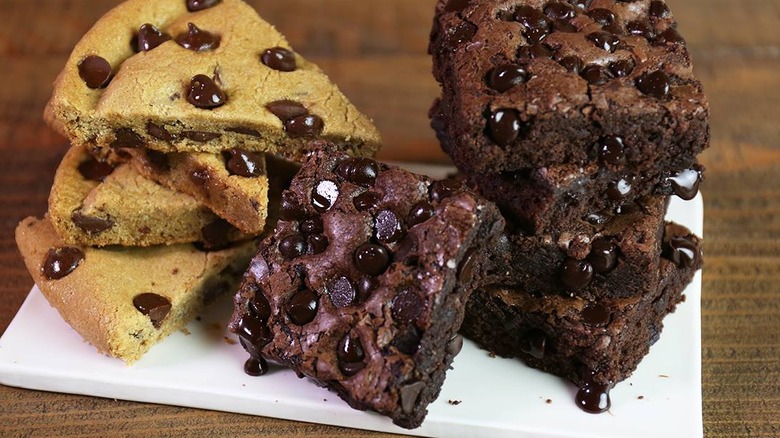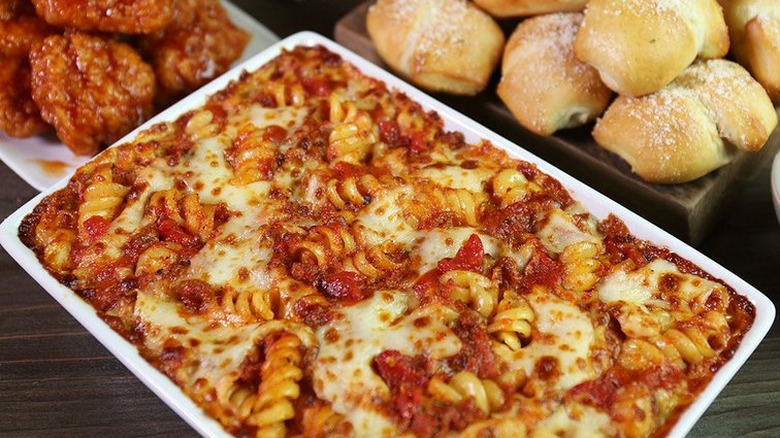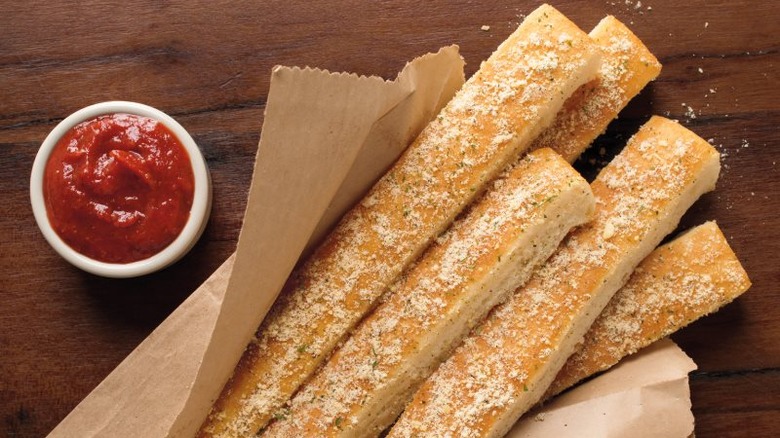Shady Things About Pizza Hut's Menu
Today, it may be one of the largest pizza chains in the U.S., but when Pizza Hut got its start in the 1950s, it was just a tiny pizza shop. Two Kansas-born brothers, Dan and Frank Carney, opened the first store in 1958 on a $600 loan from their mom in Wichita, Kansas. The store was a success, and the first franchised Pizza Hut opened a year later. By 1966, Pizza Hut had grown to 145 locations. By 1971, it was the world's largest pizza chain with stores across the U.S. and in Australia, Europe, and Canada. Today, owned by Yum! Brands, there are 19,000 locations in 100 countries. Pizza Hut's corporate offices remained in Wichita until 1995 when the headquarters moved to Texas.
But, going back to the beginning, the original Pizza Hut Menu was perfect in its simplicity. Pizza Hut's iconic pan pizza wasn't even invented until 1980. On that first menu, you could get one type of crust in only two sizes (small or large). There were seven choices of toppings to add to the fresh mozzarella cheese. In those days, Pizza Hut made its dough fresh in-house, where it was proofed, shaped into pans, and baked to order.
With thousands of locations, the personal touch that went into each pizza has been replaced with a need to get the order out the door. And in that process, some of the ways Pizza Hut does business have changed over the years, and not necessarily for the better.
The dough is frozen
Former employees have divulged that Pizza Hut no longer makes its dough fresh in the store. Instead, it's delivered frozen and is already shaped for the pan. This has been going on for some time, as a Reddit post from 13 years ago revealed. One former employee stated, "I worked at a Pizza Hut back in the early '90s. We used to make all the dough fresh every day, including actually tossing the hand-tossed dough. I was there when they made the switch to the frozen stuff." Another former employee on Reddit explained how the dough used to be made, "I started at a Hut in Northern Illinois in 1986 thru '89. We made all of the dough daily, from pre-mixed flour that we added oil and water to and mixed in a Hobart." They went on to explain from 2007 to 2012, "it was all frozen pucks and the Hobart was sold or scrapped in every store."
More recently, a former employee explained on TikTok that "a truck brings it in big boxes and they're all frozen and they're really cool disks that you can break really easily." He sums it up with, "They don't make it fresh. What you're eating is frozen dough." Although this may sound standard for a fast-food pizza chain, not every pizza shop relies on frozen dough for the pizzas. Both Domino's and Papa John's claim to use fresh, never frozen, dough.
The iconic Pan Pizza isn't the same
Pizza Hut began offering its famous pan pizza in 1980. Starting at just $1.49, customers could have a personal-sized pizza guaranteed to be ready in five minutes. Fans loved the golden brown, thick crust, which similar to focaccia bread, was soft on the inside and crispy on the bottom.
For many years, the pan pizza recipe remained the same at Pizza Hut. However, in 2019, the company made a big change. In a press statement, Pizza Hut announced a revamping of the original 1980 pan pizza recipe. With new pans and a new blend of cheese and sauce, Pizza Hut claimed to have improved the classic. Penny Shaheen, Senior Director, Culinary Innovation and Strategy said, "We've put a lot of energy and love into refining this beloved pizza and are eager for customers to taste the unbelievable difference first-hand."
However, the reception for the new recipe didn't go over as well as Pizza Hut may have hoped. One customer on Reddit complained the pan pizza was no longer as thick. A former employee responded that this can happen when employees make mistakes in prepping the dough. For example, they may "accidentally put hand-tossed frozen dough in the pan pizza pan or they let it sit in the fridge for too many days and it got puffy." The former employee went on to explain when the pan pizza rose too high, they were instructed by their manager to press it down. However, doing so created "a hand-tossed thickness of dough but presented as a normal pan pizza.
The gluten-free pizzas may not be completely gluten-free
Pizza Hut offers a gluten-free crust at many of its locations. The pizza chain has a partnership with Udi's and uses the company's certified gluten-free crusts for the pizzas. However, people with celiac disease or gluten allergies may want to steer clear of Pizza Hut's gluten-free pizzas. Although Udi's crust is certified as gluten-free, Pizza Hut can't guarantee that pizzas made with gluten-free crust aren't cross-contaminated with other gluten-containing menu items. Pizza Hut states on its website, "Pizza Hut kitchens are not gluten-free environments." Also, "we cannot assure you that our restaurant environment or any menu item will be free of gluten." And finally, "We recommend that you consult your medical advisor as to what is safe for you."
For some people with severe allergies, even ingesting a small amount of the allergen from cross-contamination can cause a reaction. A restaurant would have to take many steps to avoid cross-contamination, including careful training of employees. Since Pizza Hut can't guarantee a gluten-free pizza, there will always be a risk of cross-contamination.
The veggies come pre-sliced on a truck
Pizza Hut offers a large selection of vegetable toppings on its pizzas, including mushrooms, onions, bell peppers, Roma tomatoes, and even pineapple. However, gone are the days when Pizza Hut franchises bought fresh produce from local farmers and sliced them in the store to top the pizzas. Buying veggies pre-sliced greatly reduces the amount of time it takes to prep the pizzas. So, these days, when you order a pizza from Pizza Hut, you are getting toppings that have been pre-sliced, bagged, and delivered on a truck.
One former employee on Reddit described the process of how the corporate offices required franchises to switch to approved suppliers. This meant employees were no longer slicing fresh produce for the pizzas in the kitchen, but getting their toppings delivered already sliced. The poster stated the veggies "came in plastic bags. Whereas before we would literally order green peppers, mushrooms, onions, etc from local vendors and cut/chop them ourselves."
Pizza Hut food contains phthalates
A recent investigation from Consumer Reports uncovered a shocking amount of plasticizers are being consumed by Americans. Plasticizers are synthetic chemicals used to make plastic. They end up seeping into food from the plastic containers our food is stored in. These plastics can also enter food during processing. When Consumer Reports tested items from various fast food companies, they found Pizza Hut pizza contained phthalates.
Phthalates are a type of plasticizer that may cause health problems when consumed. Studies have linked the substance to various health problems including insulin resistance and reproductive issues. One recent study linked exposure to phthalates in childhood with an increased risk of bone cancer later in life. While another study found prenatal exposure may increase a child's risk of attention problems. One of the issues with consuming phthalates is that we simply don't know enough about the effects of the substance to be able to come up with "safe levels" that would be acceptable in food. When Consumer Reports tested Pizza Hut, they found 2,718 nanograms of phthalates in one serving of a Pizza Hut original pan pizza served in a cardboard box.
The cheese comes frozen and pre-shredded
To speed up the pizza-making process in its restaurants, Pizza Hut buys pre-shredded cheese from a well-known manufacturer that supplies prepared cheese to many restaurants. Although Americans may have never heard of the brand Leprino Foods, they've likely eaten it if they indulge in take-out pizza. Leprino Foods produces one billion pounds of cheese annually and is a major supplier of cheese in the pizza industry.
Pizza Hut's partnership with Leprino Foods goes all the way back to 1968. In fact, Pizza Hut was one of the first pizza chains to begin using shredded cheese on pizzas as opposed to cheese slices. However, rather than get its cheese in a block form and shred it at the store, today Pizza Hut buys pre-shredded cheese.
Although shredded cheese offers convenience and melts more evenly than slices of cheese, there are issues with using it on pizzas. For one thing, it contains substances like cellulose powder (sawdust) to keep it from reforming into one big clump of solid cheese. Cellulose powder isn't a toxic substance. However, eating too much of it can lead to gas and bloating. The other issue with using shredded cheese with additives like cellulose powder is that it can cause the cheese to melt less smoothly. If you're making a pizza at home, experts recommend freshly grating a block of cheese rather than buying pre-shredded bags.
Many menu items contain TBHQ
Tertiary butylhydroquinone, or TBHQ, is a controversial food additive linked to many health problems. TBHQ is used to extend the shelf life of food. It can be found in processed foods, and the FDA has a limit on how much TBHQ in foods is allowed. Various research on TBHQ has disturbing findings, including this study by the Centers for Science in the Public Interest (CSPI) which linked TBHQ to tumors in rats. Other studies have linked TBHQ to a host of health issues including ADHD, immunity problems, asthma, and allergic reactions. Experts recommend children with ADHD avoid eating products that contain TBHQ.
You can find out if a food contains TBHQ by looking at the ingredients list. It may be listed as TBHQ, butylated hydroxyanisolor, or tertiary butylhydroquinone. Pizza Hut's ingredient statement shows TBHQ is lurking in many of its foods, including chicken wings, hand-tossed crust, pan pizza crust, breadsticks, and even the oil used to cook the pizzas.
The brownies are not fresh
Brownies are a relatively easy dessert to make. When you order a brownie from Pizza Hut's dessert menu, you may think you will be getting a freshly made brownie. Or you may expect to get a brownie made in the restaurant from a mix or pre-made batter. However, this is not the case. Former employees have revealed that Pizza Hut's brownies are not made in-house — even from a mix. Rather, they are delivered to the restaurants pre-cooked in tins. The conveyor belts that send the pizzas through the ovens are also used to heat the tins of brownies.
According to a Reddit post, "They're frozen in the tinfoil pans. At my location we put them in a pan and cover it." For an even bigger time-saving measure, another employee on Reddit mentioned they no longer cut the brownies into squares. Instead, "we stopped cutting our cookies and brownies and just started putting knives in there lol." While this might be more time-efficient, it's also a bit lazy on Pizza Hut's end.
The pasta comes frozen and is cooked on a conveyor belt with the pizzas
After a short-lived stint in the '70s, Pizza Hut began serving pasta in 2008 and briefly renamed itself Pasta Hut to create a buzz around its new offerings. The pasta was a hit and brought in $24 million in sales in the first month it was offered. Today, Pizza Hut's menu still has several choices of pasta dishes such as the oven-baked chicken Alfredo pasta or the oven-baked cheesy Alfredo pasta.
Like many menu items at Pizza Hut, the pasta is not prepared by employees in the kitchen. The noodles are not even boiled on-site. Instead, the pasta dishes arrive prepared with the noodles cooked and mixed with the sauce. The pasta dishes are frozen in foil trays. When a customer places an order, the tray is placed on the same conveyor belts the pizzas are cooked on. Reviews for the pasta can be negative, with one Reddit poster stating, "water has more flavor than this." Ouch.
The breadsticks arrive at the store as a sheet of frozen dough
Pizza Hut's famous breadsticks have inspired many copycat recipes. When done right, they are golden brown on the outside with a soft, fluffy interior and sprinkled on both sides with a mix of seasonings and Parmesan cheese. This special mix is sometimes referred to as Pizza Hut's "fairy dust." However, at some point, the method for prepping the breadsticks changed from proofing fresh dough in the kitchen to stores getting a shipment of pre-made frozen dough. This employee explains on Reddit how the breadsticks are prepared, "Fun fact, the dough actually comes frozen and at the end of the night one of the job duties is to oil the pans and put the frozen breadstick dough in with it. As the dough defrosts and rises overnight, it soaks up all the oil."
Today, like so many other menu items, the breadsticks are no longer made in-house but arrive at stores ready to be baked. The sheets of breadsticks are perforated with indentations to break apart before baking. However, it's been reported on Reddit that occasionally employees forget to break the breadsticks apart, and customers have received one great big slab of breadsticks. As this employee explains in a comment, "the dough sheets now came perforated. They are supposed to be broken into individual stick shapes while still frozen."
The app may charge you for multiple orders
Pizza Hut has the distinction of being not only the first company to sell pizza over the Internet but also the first physical good ever purchased online. In 1994, Pizza Hut introduced "PizzaNet." The very first person to ever order a pizza online requested a large pepperoni and mushroom pizza with extra cheese on their dial-up connection.
Today, Pizza Hut has a delivery app for customers to conveniently place orders online and receive their pizzas. But although the brand has had many years to get it right, Pizza Hut gets many complaints on ordering from both its website and its app. This Reddit poster complained, "can't make special requests or redeem rewards without an error message and it's just generally a slow and glitchy app." Another app user on Reddit experienced triple notifications from their bank, although Pizza Hut never received the order. And finally, this Pizza Hut employee went to Reddit to ask others, "I have been having complaints about double charges with Apple Pay ... anyone else has this trouble too?"
The stuffed crust pizza is made with string cheese
It may seem like magic when you bite into Pizza Hut's stuffed pizza crust and reach all that gooey mozzarella cheese, but the process for getting the cheese into the crust is very simple. However, we'll get to that shortly. First, let's look at a brief history. Stuffed crust pizza has only been around since the 1990s. It was 1995 when Pizza Hut began running ads for its original stuffed crust, urging customers to eat the pizza backward. It was an instant hit, bringing in over $300 million in sales in its first year.
To make the crust, former employees have revealed the secret on Reddit. The poster said the cheese Pizza Hut stuffs into the crust is just simple string cheese. "End of story, nothing glamorous, just simple beauty," they explained. If you'd like to try making stuffed crust pizza at home, simply place string cheese over the dough at the edge of the pan. Fold the dough over the string cheese, press it down firmly, and bake your pizza. Voila, you've just made a stuffed-crust pizza.
